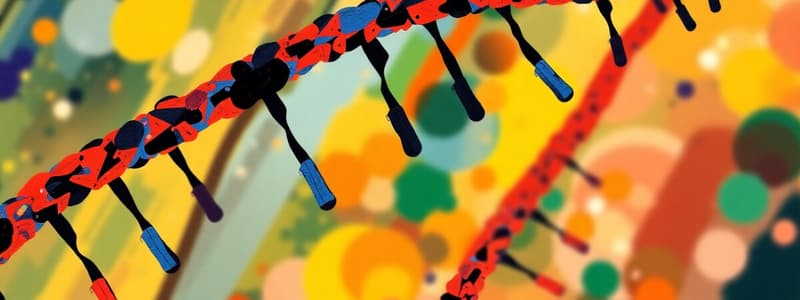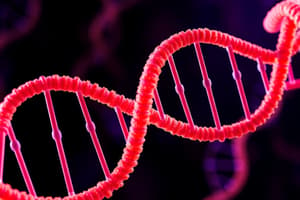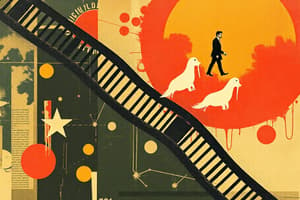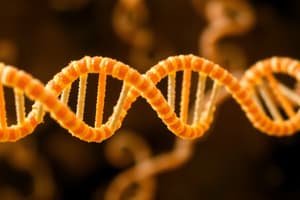Podcast
Questions and Answers
What is the role of RNA polymerase during transcription?
What is the role of RNA polymerase during transcription?
- It separates RNA from DNA.
- It modifies the RNA after transcription.
- It synthesizes the RNA chain. (correct)
- It unwinds the DNA helix.
Introns are the coding regions of nucleic acids that remain in the final mRNA.
Introns are the coding regions of nucleic acids that remain in the final mRNA.
False (B)
Which of the following phases does NOT belong in the transcription process?
Which of the following phases does NOT belong in the transcription process?
- Termination
- Translocation (correct)
- Initiation
- Elongation
What is the primary function of transfer RNA (tRNA)?
What is the primary function of transfer RNA (tRNA)?
The pre-mRNA transcript can exit the cell's nucleus before processing.
The pre-mRNA transcript can exit the cell's nucleus before processing.
Transcription and translation occur simultaneously in eukaryotic cells.
Transcription and translation occur simultaneously in eukaryotic cells.
Which type of RNA is most abundant in the cell?
Which type of RNA is most abundant in the cell?
What is the purpose of the A-site in ribosomes?
What is the purpose of the A-site in ribosomes?
Match the following components with their roles in transcription:
Match the following components with their roles in transcription:
What are alleles?
What are alleles?
RNA polymerase is responsible for the initiation of transcription.
RNA polymerase is responsible for the initiation of transcription.
During RNA processing, the sections of RNA that are non-coding are called ______.
During RNA processing, the sections of RNA that are non-coding are called ______.
Name the four phases of translation.
Name the four phases of translation.
What are the three stages of transcription?
What are the three stages of transcription?
A dominant allele is only expressed when paired with another dominant allele.
A dominant allele is only expressed when paired with another dominant allele.
Match the type of RNA with its function:
Match the type of RNA with its function:
What is the start codon for translation?
What is the start codon for translation?
What is the terminator sequence in transcription?
What is the terminator sequence in transcription?
In eukaryotic cells, transcription occurs in the __________.
In eukaryotic cells, transcription occurs in the __________.
During translation termination, _______ factors interact with the stop codons.
During translation termination, _______ factors interact with the stop codons.
What is the importance of genetics?
What is the importance of genetics?
What distinguishes a wild-type phenotype from a mutant allele?
What distinguishes a wild-type phenotype from a mutant allele?
What are the three parts of a nucleotide?
What are the three parts of a nucleotide?
The set of alleles for a given trait is called the ______.
The set of alleles for a given trait is called the ______.
Match the following DNA components with their characteristics:
Match the following DNA components with their characteristics:
Transcription results in the synthesis of __________.
Transcription results in the synthesis of __________.
What is the primary function of RNA?
What is the primary function of RNA?
What is the term used for the visible expression of the genotype?
What is the term used for the visible expression of the genotype?
What is genotype?
What is genotype?
What is phenotype?
What is phenotype?
Which molecule holds the genetic information?
Which molecule holds the genetic information?
What type of sugar is contained in DNA?
What type of sugar is contained in DNA?
Which of the following differentiates between euchromatin and heterochromatin?
Which of the following differentiates between euchromatin and heterochromatin?
Eukaryotic transcription is the same as prokaryotic transcription.
Eukaryotic transcription is the same as prokaryotic transcription.
What is the structure of DNA?
What is the structure of DNA?
What are the two varieties of nucleic acids?
What are the two varieties of nucleic acids?
What is central dogma?
What is central dogma?
What is the maturation process of mRNA?
What is the maturation process of mRNA?
What does UGA usually specify in the genetic code?
What does UGA usually specify in the genetic code?
What is the role of RNA polymerase II?
What is the role of RNA polymerase II?
What are introns in eukaryotes?
What are introns in eukaryotes?
Flashcards are hidden until you start studying
Study Notes
Transcription & Translation
- Transcription is the process of synthesizing single-stranded RNA from a double-stranded DNA template.
- Translation is the first stage of protein biosynthesis from RNA. It involves the formation of a polypeptide using mRNA as a template.
- Ribosomal RNA (rRNA) is the most abundant RNA type in cells, serving as a structural component of the ribosome.
- Transfer RNA (tRNA), the second most abundant RNA type, carries amino acids to the ribosome for protein synthesis.
- Messenger RNA (mRNA) carries information specifying the amino acid sequence of a protein.
- In eukaryotic cells, the nuclear envelope separates transcription from translation.
- Extensive RNA processing occurs in the nucleus.
- Transcription is the first step in gene expression and involves the synthesis of mRNA from a DNA template.
- Transcription occurs in the 5’-3’ direction.
- During transcription, RNA polymerase reads a DNA sequence and produces a complementary and antiparallel RNA strand.
- The stretch of DNA transcribed into an RNA molecule is called a transcription unit.
- Transcription in prokaryotes occurs in the cytoplasm alongside translation, while eukaryotic transcription occurs only in the nucleus.
- Prokaryotic DNA not currently being used is stored as heterochromatin around histones to form nucleosomes, and must be unwound as euchromatin to be transcribed.
- Transcription has three stages: Initiation, Elongation, and Termination.
Initiation
- RNA polymerase binds to a specific DNA region called the promoter site and initiates transcription.
- RNA polymerase is the enzyme responsible for transcription.
- RNA polymerase has five subunits: 2α subunits, β subunit, β' subunit, and ω subunit.
- Once RNA polymerase binds to the promoter, DNA unwinds and the enzyme starts transcribing the template strand.
- The position of the first synthesized base of the RNA is called the start site.
Elongation
- RNA polymerase moves along the DNA template and sequentially synthesizes the RNA chain.
- DNA unwinds ahead of the moving polymerase and the helix reforms behind it. The polymerase unwinds 10-20 DNA bases at a time.
- RNA polymerase adds nucleotides in the 5’-3’ direction.
Termination
- Transcription stops when RNA polymerase reaches a section of DNA called the terminator.
- The terminator sequence is AAUAAA.
- The RNA strand is released and RNA polymerase dissociates from the DNA.
- The RNA strand undergoes further processing.
RNA Processing
- The original transcript from DNA is called pre-mRNA.
- Pre-mRNA contains transcripts of both introns and exons.
- Introns are non-coding sections of nucleic acid found between coding regions.
- Exons are coding regions of nucleic acids.
- Pre-mRNA never leaves the cell's nucleus.
- Introns are excised and exons are joined together to form mRNA.
- The removal of introns is called splicing.
Translation
- Translation is the process of forming a polypeptide (protein) by decoding mRNA produced in transcription.
- Translation occurs in ribosomes, present in the cytoplasm.
- Translation starts after mRNA enters the cytoplasm.
- Translation uses tRNA as the interpreter of mRNA.
Phases of Translation
- Translation proceeds in four phases: Initiation, Elongation, Translocation, and Termination.
Initiation
- The initiation stage of translation brings together mRNA, tRNA bearing the first amino acid of the polypeptide, and the two subunits of a ribosome.
- The components involved are the large and small subunits of the ribosome, mRNA, initiator tRNA in its charged form, and three factors (IF1, IF2, IF3) and GTP.
- tRNA with an amino acid linked to it is termed "charged tRNA."
- IF1 and IF2 bind to the free 30S subunit.
- IF3 complexed with GTP then binds to the small subunit.
- IF3 assists the charged initiator tRNA to bind.
- The assembled ribosome has two tRNA binding sites: the A-site (acceptor) for aminoacyl and the P-site (donor) for polypeptide.
- The A-site is where incoming aminoacyl-tRNA molecules bind, and the P-site is where the growing polypeptide chain is found.
- One major outcome of initiation is the placement of initiator tRNA in the P-site.
- Start codon: AUG
- Start anticodon: UAC
- The small ribosomal subunit attaches to the 5' end of mRNA.
Elongation
- In this stage, amino acids are added one by one to the first amino acid.
- In codon recognition, mRNA codon in the A-site forms hydrogen bonds with the tRNA anticodon.
- In peptide bond formation, the ribosome catalyzes the formation of the peptide bond between the amino acids.
- The polypeptide extending from the P-site moves to the A-site to attach to the new amino acid.
- Elongation involves three elongation factors.
Translocation
- The tRNA with the polypeptide chain in the A-site is translocated to the P-site.
- tRNA at the P-site moves to the E-site and leaves the ribosome.
- The ribosome moves down the mRNA in the 5’-3’ direction.
Termination
- Protein factors called release factors interact with the stop codons and cause release of the completed polypeptide chain.
- Stop codons: UAA, UAG, UGA
- RF1 recognizes the codons UAA and UAG.
- RF2 recognizes UAA and UGA
- RF3 helps RF1 and RF2 carry out the reaction.
Translation in Eukaryotes
- Eukaryotes have at least nine initiation factors.
- Eukaryotic initiator tRNA does not become formylated as in prokaryotes.
- The factors eEF1a, eEF1b, and eEF2 are involved in elongation.
- Eukaryotes have only one release factor, eRF, which recognizes all the stop codons.
Genetics & Individuals
- Genetics is important for individuals, society, and the study of biology
Genetic Variation & Alleles
- The variant eye color gene discovered in Drosophila is an allele
- Alleles are alternative forms of a gene.
- Different alleles may produce differences in an organism's phenotype.
- Genotype is the set of alleles for a trait carried by an organism.
- Thomas Hunt Morgan used the fruit fly, Drosophila melanogaster, to study genetics
Dominant & Recessive Alleles
- A dominant allele is expressed even when paired with a recessive allele.
- A recessive allele is only visible when paired with another recessive allele.
Chromosomes & Genotype/Phenotype
- Every gene has a specific location, or locus, on a chromosome
- Genotype is the combination of alleles in an organism
- Phenotype is the visible expression of the genotype
- Wild-type phenotype is the most common or standard phenotype
- Mutant alleles are usually recessive
The Chemical Nature of Genes
- DNA holds the genetic information
The Structure of DNA
- The discovery of the double helix launched the era of molecular genetics.
- DNA is the genetic material of all cellular organisms and most viruses.
- DNA is a gigantic molecule that encodes genetic information for all life.
- DNA is responsible for preserving, copying, and transmitting information within cells and across generations.
- DNA consists of two strands held together by hydrogen bonds between bases.
- The strands possess antiparallel polarity.
- The curving sides of the DNA ladder represent the sugar-phosphate backbone.
- DNA is stabilized by hydrogen bonds between the bases.
Nucleic Acids
- Nucleic acids are polymers of nucleotides.
- Two types of nucleic acids exist: DNA and RNA.
- DNA stores genetic information and replicates itself.
- DNA codes for the sequence of amino acids in proteins.
- RNA performs various functions within cells, including protein synthesis and gene expression regulation
Structure of DNA & RNA
- DNA contains deoxyribose sugar, adenine, guanine, cytosine, and thymine.
- DNA is double-stranded with base pairing.
- DNA has a helix structure.
- RNA contains ribose sugar, adenine, guanine, cytosine, and uracil.
- RNA is single-stranded.
- RNA does not have a helix structure.
Central Dogma
- The central dogma describes the flow of genetic information from DNA to RNA to protein.
Nucleotides
- Each nucleotide consists of a phosphate group, a pentose sugar, and a nitrogen-containing base.
- Five types of nucleotides are found in nucleic acids: adenine, guanine, cytosine, thymine, and uracil.
- Nucleotides are joined by dehydration synthesis reactions to form a strand, which is a linear sequence of nucleotides.
DNA Structure
- The backbone of a nucleic acid strand consists of alternating sugar-phosphate molecules.
- DNA consists of two strands held together by hydrogen bonds between nitrogen-containing bases.
- The two strands twist around each other, forming a double helix.
Base Pairing
- Adenine (purine) bonds with thymine (pyrimidine)
- Cytosine (pyrimidine) bonds with guanine (purine)
- This bonding is called complementary base pairing.
- The number of A + G (purines) equals the number of T + C (pyrimidines).
Packing DNA in Cells
- Large amounts of DNA are packed into a cell.
Eukaryotic Chromosome Structure
- Chromosomes are made up of chromatin.
- Chromatin is a complex of DNA and protein.
- Chromatin condenses to form chromosomes during cell division.
- The DNA in chromosomes is highly organized into nucleosomes.
Eukaryotic Chromosomes
- Eukaryotic chromosomes possess centromeres and telomeres.
- Centromeres help attach and separate chromosomes during cell division.
- Telomeres protect the ends of chromosomes from degradation.
Types of DNA Sequences in Eukaryotes
- Unique Sequence DNA: includes protein-encoding genes and gene families.
- Moderately Repetitive DNA: includes tandem repeat sequences, and interspersed repeat sequences such as SINEs and LINEs.
- Highly Repetitive DNA or satellite DNA: repetitive sequences
Introduction to Genetics
- Genetic variation is key to understanding differences between individuals
- Genetics is crucial for individuals, society, and the study of biology
Genetic Variation
- Genetic variation is caused by alleles, alternative forms of genes.
- Different alleles can lead to different phenotypes (observable traits)
- Genotype is the combination of alleles an organism carries.
- Thomas Hunt Morgan used Drosophila melanogaster to study genetics
Dominant vs Recessive alleles
- Dominant alleles are expressed even when paired with a recessive one
- Recessive alleles are only visible when paired with another recessive allele
Hypothetical Chromosomes
- Each gene has a specific location (locus) on a chromosome
- Genotype is the combination of alleles in an organism
- Phenotype is the visible expression of the genotype
- Wild-type phenotype is the most common
- Mutant alleles are usually recessive
DNA as the genetic material
- DNA holds genetic information
Structure of DNA
- Discovery of the DNA double helix marked the beginning of Molecular Genetics.
- DNA is a gigantic molecule that encodes genetic information for all life.
- DNA preserves, copies, and transmits information within cells and across generations.
- DNA's double helix structure has two sugar-phosphate backbones connected by base pairs.
- DNA strands have antiparallel polarity.
- Hydrogen bonds between bases stabilize the double helix structure.
Nucleic Acids
- Nucleic acids are polymers of nucleotides.
- Two main types of nucleic acids:
- DNA (deoxyribonucleic acid) stores information for replication and protein synthesis.
- RNA (ribonucleic acid) plays various roles in cells, including protein synthesis and gene regulation.
DNA vs. RNA Structure
- DNA has deoxyribose sugar, while RNA has ribose sugar.
- DNA has thymine as a base, while RNA has uracil.
- DNA is double-stranded with base pairing, while RNA is single-stranded.
- DNA forms a helix, while RNA does not.
Nucleotide Structure
- Each nucleotide consists of:
- Phosphate group
- Pentose sugar
- Nitrogenous base
DNA and RNA Structure
- DNA contains adenine, guanine, cytosine, and thymine.
- RNA contains adenine, guanine, cytosine, and uracil.
- Nucleotides join via dehydration synthesis to form a linear strand.
- The backbone of a nucleic acid strand is composed of alternating sugar-phosphate molecules.
- DNA has two strands held together by hydrogen bonds between bases, forming a double helix.
- Base pairing in DNA is complementary: adenine with thymine, and cytosine with guanine.
- The number of purines (A + G) always equals the number of pyrimidines (T + C).
DNA Packaging in Cells
- Large amounts of DNA are packed into a cell's nucleus.
Eukaryotic Chromosome Structure
- Eukaryotic chromosomes have a complex structure.
Eukaryotic Chromosomes: Centromeres and Telomeres
- Eukaryotic chromosomes possess centromeres and telomeres.
DNA sequence types in Eukaryotes
- Unique sequence DNA:
- Protein-encoding genes
- Gene families
- Moderately repetitive DNA:
- Tandem repeat sequences
- Interspersed repeat sequences (SINE & LINE)
- Highly repetitive DNA or satellite DNA:
- Highly repetitive sequences.
DNA Organization/DNA Structure
- DNA is composed of a sugar-phosphate backbone, with bases (adenine, guanine, cytosine, and thymine) attached, connected by hydrogen bonds forming base pairs (A-T and G-C).
- DNA is organized into chromatin, which is packed into chromosomes for efficient storage and manipulation.
Central Dogma
- The central dogma describes the flow of genetic information from DNA to RNA to proteins.
- Transcription: The DNA sequence is used to create a complementary RNA sequence (mRNA).
- mRNA moves to the cytoplasm and binds to ribosomes.
- Translation: The information encoded in mRNA is used to synthesize proteins.
- This involves nucleotide triplets called codons, each encoding for a specific amino acid.
Genetic Code
- The genetic code is nearly universal, the same codons for different organisms, but there are exceptions like in mitochondria.
- The genetic code is redundant, meaning multiple codons can code for the same amino acid.
- The genetic code was discovered by studying cell-free protein synthesis in bacteria.
- The code was deciphered by using mRNA with specific nucleotide sequences and observing the amino acids incorporated into proteins.
Transcription
- Transcription is the process of making RNA from DNA.
- It requires RNA polymerase, which binds to a promoter sequence on DNA to initiate transcription.
- RNA polymerase moves along the DNA template, creating a complementary RNA molecule.
- Transcription terminates when RNA polymerase encounters a termination sequence.
Eukaryotic Transcription
- RNA polymerase II (RNAP II or Pol II) is the main polymerase involved in transcribing mRNA, small nuclear RNA (snRNA), and microRNA.
- Eukaryotic transcription occurs in the nucleus, and the mRNA undergoes processing before being translated into proteins.
Maturation of mRNA
- mRNA undergoes processing after transcription to produce a mature transcript ready for translation.
- Capping: A 5' cap is added to the mRNA molecule.
- Splicing: Introns, non-coding sequences, are removed from the pre-mRNA.
- Polyadenylation: A poly-A tail is added to the 3' end of the mRNA.
- Introns are removed by a complex process involving small nuclear ribonucleoproteins (snRNPs).
- These processes are critical for the regulation and efficiency of protein synthesis.
Studying That Suits You
Use AI to generate personalized quizzes and flashcards to suit your learning preferences.





